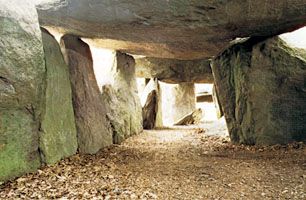The archaeology of Oceania involves, for the most part, short time perspectives, because migrations within the open Pacific could have occurred only after the development of seagoing canoe navigation in Neolithic times. The exception is the New Guinea–Australia region, where the ancestors of indigenous peoples evidently arrived in Paleolithic times.
The long-term history of the Oceanic peoples, especially the Polynesians, has been the subject of many theories. Scholars reject ideas involving a lost continent (e.g., Lemuria, Mu) or direct relations with the Middle East (e.g., the Ten Lost Tribes, migrations of Children of the Sun from Egypt), early India (e.g., Indus Valley–Easter Island connections), or Japan (e.g., supposed language relations). They also insist that, while eastern-voyaging Polynesians could well have reached the American continent and some may have found their way back into the islands, none of the various theories claiming that Oceanic peoples had their homelands in North or South America is scientifically credible (e.g., Ettie A. Rout’s Maori Symbolism, Thor Heyerdahl’s thesis for the Kon-Tiki voyage). Similarly, they reject theories explaining the Pre-Columbian civilizations on the American continent in terms of influences by way of the tropical Pacific islands from Asia. Most archaeological, linguistic, and ethnological evidence continues to support the long-standing hypothesis of the settlement of Oceania by a succession of migrants from the Southeast Asia region, with at most very minor contacts eastward to America.
The archaeological record begins when early Homo sapiens populations, comparable with the fossils of Wadjak in Java, Aitape in New Guinea, and Keilor and others in Australia, were moving eastward. This apparently occurred during the Fourth Glacial Epoch, when sea levels were lower, land pathways perhaps more uplifted, and inter-island channels narrower than now. Early humans could migrate with lessened water obstructions from the Asiatic continental platform (Sunda Shelf) through the intermediate Celebes–Molucca–Lesser Sunda zones on to the Australian continental platform (Sahul, or Papuan, Shelf). Some scholars suggest such movements even during the Third Glacial, but this seems dubious. Core tools typologically Paleolithic and sometimes heavily patinated occur in both Southeast Asia and Australia, and flake tools often of microlithic size are found in the intermediate zones (e.g., Timor) as well. Yet all these are surface finds or of dubious age when at subsurface levels. Doubtless most early groups moved, in glacial times, near shorelines now inundated, though valleys suitable for inland hunting or locally uplifted coasts might yield finds. The vital western New Guinea region, much of which is swampy and lacking stone, has had little systematic study.
The hypothetical picture has the isolated Australian and Tasmanian populations developing along regional and local lines characteristic of their later archaeological perspectives: generally Paleolithic, but with some Neolithic and also recent Malay trading contacts along the northern coasts. The New Guinea region was penetrated by canoe-migrating peoples carrying Neolithic elements that come to dominate the picture. The evidence suggests that the first comers were “dry” gardeners living in semi-sedentary hamlets, with stone tools including adzes and axes of oval cross section; such shifting cultivators are found still from Southeast Asia to the Solomon Islands and Vanuatu (New Hebrides). The Melanesian areas were also penetrated, apparently later and especially along the coasts, by village-living peoples with more sedentary cultivation; stone construction in various forms; finer tools, including quadrilateral cross-section types; stone pestles and mortars; pottery; and other later Neolithic elements. In New Guinea, as shown by Alphonse Riesenfeld, these influences appeared to arrive by way of the northeastern coast from the outer fringe of islands, perhaps the Bismarcks, Admiralties, and others. Unhappily, archaeological work in all these Melanesian zones has been limited to sporadic surface collecting and recording and to occasional tools turned up by garden workers or miners; time-sequence definitions are out of the question except as they may be inferred from Neolithic chronology in Southeast Asia.
By contrast, archaeological work in Polynesia and some zones of Micronesia is considerably more advanced. For northwestern Micronesia a vital clue is a radiocarbon dating of approximately 1527 bce from a stratified deposit excavated in the Marianas. Collateral evidence suggests that occupation may go back to 2000 bce. The Mariana latte sites (rows of capped stone pillars, probably posts of important houses), together with stone mortars, pottery, and other artifacts, suggest migrations from the Philippines area in late Neolithic times.
Farther east, the low coral islands of the Carolines, Marshalls, and Gilberts yield limited artifacts of shell, bone, and coral rock capable of some comparative study. The few high islands in this part of Micronesia, however, have extensive stone construction and other more diversified elements. Yap, for example, has stone ceremonial platforms, stepped tombs, “stone money,” pottery, etc. Ponape’s most spectacular site, the “Venice” called Metalanim, has several acres of stone-faced islands and canals, the principal structure being a rectangular enclosure with double walls up to 40 feet high containing a central stepped tomb and also vault tombs. A much smaller Venice exists on Kosrae (formerly Kusaie), most easterly of the Carolines. Scholars generally attribute such elaborations of the basic stonework elements, in Polynesia as well as Micronesia, to local creativity rather than undemonstrated outside influences.
Micronesia and Polynesia may usefully be treated as a continuous zone. With them, too, may justifiably be placed the Fiji zone of eastern Melanesia, the most easterly limit of the potter’s craft. In compiling known data on stonework in this whole area, one may distinguish two great types: one to the west (Micronesia, Fiji, Tonga, Samoa areas), characterized by ceremonial courts, perhaps with god houses, and platform tombs often of stepped types; the other to the east (Societies, Hawaii, New Zealand, and islands eastward to Easter Island), characterized by temple structures, usually with altars, standing stones probably as backrests for gods and priests in the rituals, and cist burials within the structures. From simpler shrines having a few standing stones (e.g., inland Tahiti, New Zealand, small, outlying Hawaiian islands), the Polynesian temple became elaborated into various local forms including usually larger-size and “megalithic” stonework. In Hawaii wooden posts or images generally replaced standing stones. In the Tuamotus huge coralline slabs were often used, and in the Marquesas the stones were sometimes carved in human (or god) form. Some specialists consider that such comparative study solves the “mystery” of the Easter Island statues. Rather than being relics of some lost continent or pre-Polynesian migration, they follow this last pattern of carved figures, standing on altar platforms (called by the standard Polynesian name ahu) in which there are cist burials. Apparently a local inventive urge toward large size, combined with the presence of easily worked volcanic tuff, produced this one of the many variants of the Polynesian place of worship.
Such local constructions, however, together with other more spectacular elements, such as widely scattered petroglyphs and a dubiously old “script” on Easter Island, have less significance for historical reconstruction than detailed study of variability in minor artifacts.
Theories of contacts with the American continent must be treated with caution so far as they lean on gross parallels such as stone images or art resemblances; the most concrete evidence has been the presence of the sweet potato, apparently an American plant, in Oceania in prehistoric times.
Felix M. Keesing The Editors of Encyclopaedia Britannica
Source link : https://www.britannica.com/event/Stone-Age/Oceania
Author :
Publish date : 2024-09-12 03:00:00
Copyright for syndicated content belongs to the linked Source.




